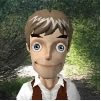This is a bad photo of the first bootleg album I owned (and no, I no longer own it -- this image came from the interwebs.) It's a live recording of Frank Zappa and the Mothers with Zubin Mehta (and the Los Angeles Philharmonic at Pauley Pavilion? Details are fuzzy, both in the photo and in my brain.) They're performing music from what was eventually "200 Motels", and Frank kicks things off with "Hit it, Zubin!"
The record wasn't very good (surprise!) A.: because it's an audience recording, and B: only very late in his life could Frank afford enough rehearsal time for an orchestra, so the performance is a little rough too. But still! A bootleg! Totally unvarnished and unofficial!
As I mentioned in my post about Dylan's Basement Tapes, long before file-sharing, downloading and the internet, bootlegs were the only way to hear unreleased performances, either live recordings, demos or songs recorded in studio sessions but never released on LP. For me, live recordings were dicey, because early on they were recorded by someone sneaking a cassette player into a show. (Later releases were recorded from the soundboard or via radio broadcasts. Since the copyright laws are looser overseas, many late '60s /early '70s radio concert broadcasts are now coming out on CD.)
Bootlegs also took advantage of arcane record company policies -- many British bands never had their early singles released in the States, so boots filled that need.
There were many famous bootlegs, and naturally they featured the most popular bands: the Beatles, the Rolling Stones, the Who..., you know, any band with a 'the' in front. Although the Beatle's Get Back sessions (from the filming of "Let It Be") were eye-opening in a behind-the-veil kind of way, it wasn't something you'd slap on the old turntable for fun, For example, check out the officially sanctioned Beatles "Anthology" series. Sure it's fun the first time you hear Take One of "Strawberry Fields Forever", but the thing is, the Beatles really crafted their final product. Outtakes just don't make it.
Many stores didn't carry bootlegs, and if they did, it was in a special section near the back of the store. Early boots were basically white sleeves rubber stamped with the titles (and I still maintain that the cover of "The Beatles" (the 'white album') was supposed to look like a common bootleg album.)
Things got a little better in the CD era, but not much.
We used to carry bootlegs at Northern Lights, usually displayed up front where we could keep an eye on them (yes, ironic that we didn't want anyone to steal what was at heart stolen merchandise itself). I still have a few Pink Floyd discs (early singles since released as bonus tracks) and a few Radiohead discs (once again, early singles collected, and a radio concert broadcast or two), and my prize possession is the collection of Beatle's fan club Christmas releases.1963-1969.
We had one guy who'd buy every Neil Young boot we could get in stock, and we sold lots of Pearl Jam and Nirvana; Dylan not so much by then, but still a market for Beatles material. As was typical of the Northern Lights purchasing strategy, we'd buy, sparingly, whatever artist was popular at the time, so I remember some Tori Amos boots that gathered dust.
Record labels seem to finally realize the value of rare and/or unreleased material, as box sets are packed to the gills with what once was the mainstay of bootleg culture. And then there's the internet...
Frank Zappa even released the 'Beat the Boots' series, basically re-releasing already existing boots under the official Zappa banner, not as a way of bestowing legitimacy but instead taking the product back from the pirates and cashing in. Too bad my Zappa/Zubin boot wasn't included. Think I'll check YouTube....

































